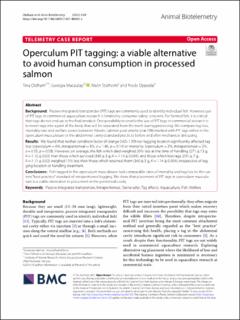| dc.contributor.author | Oldham, Tina Marie Wier | |
| dc.contributor.author | Macaulay, Georgia | |
| dc.contributor.author | Stalheim, Malin | |
| dc.contributor.author | Oppedal, Frode | |
| dc.date.accessioned | 2021-10-04T08:47:08Z | |
| dc.date.available | 2021-10-04T08:47:08Z | |
| dc.date.created | 2021-09-22T13:43:20Z | |
| dc.date.issued | 2021 | |
| dc.identifier.issn | 2050-3385 | |
| dc.identifier.uri | https://hdl.handle.net/11250/2787381 | |
| dc.description.abstract | Background: Passive integrated transponder (PIT) tags are commonly used to identify individual fish. However, use of PIT tags in commercial aquaculture research is limited by consumer safety concerns. For farmed fish, it is critical that tags do not end up in the final product. One possibility to enable the use of PIT tags in commercial research is to insert tags into a part of the body that will be separated from the trunk during processing. We compare tag loss, mortality rate and welfare scores between Atlantic salmon post-smolts (n = 798) marked with PIT tags either in the operculum musculature or the abdominal cavity (standard practice) before and after mechanical delousing.
Results: We found that neither condition factor (K) (range 0.60–1.99) nor tagging location significantly affected tag loss (operculum = 6%, intraperitoneal = 8%, z = 1.46, p = 0.14) or mortality (operculum = 2%, intraperitoneal = 2%, z = 0.55, p = 0.58). However, on average, the fish which died weighed 20% less at the time of handling (271 ± 13 g, K = 1.12 ± 0.02) than those which survived (340 ± 3 g, K = 1.14 ± 0.004), and those which lost tags (291 ± 7 g, K = 1.11 ± 0.02) weighed 15% less than those which retained them (340 ± 3 g, K = 1.14 ± 0.004), irrespective of tagging location or handling treatment.
Conclusions: Fish tagged in the operculum musculature had comparable rates of mortality and tag loss to the current “best practice” standard of intraperitoneal tagging. We show that placement of PIT tags in operculum musculature is a viable alternative to placement in the peritoneal cavity. | en_US |
| dc.language.iso | eng | en_US |
| dc.publisher | BMC | en_US |
| dc.rights | Navngivelse 4.0 Internasjonal | * |
| dc.rights.uri | http://creativecommons.org/licenses/by/4.0/deed.no | * |
| dc.title | Operculum PIT tagging: a viable alternative to avoid human consumption in processed salmon | en_US |
| dc.type | Journal article | en_US |
| dc.type | Peer reviewed | en_US |
| dc.description.version | publishedVersion | en_US |
| dc.rights.holder | Copyright 2021 the authors | en_US |
| dc.source.articlenumber | 39 | en_US |
| cristin.ispublished | true | |
| cristin.fulltext | original | |
| cristin.qualitycode | 1 | |
| dc.identifier.doi | 10.1186/s40317-021-00261-z | |
| dc.identifier.cristin | 1937159 | |
| dc.source.journal | Animal Biotelemetry | en_US |
| dc.relation.project | Havforskningsinstituttet: 14930 | en_US |
| dc.relation.project | Havforskningsinstituttet: 14597 | en_US |
| dc.identifier.citation | Animal Biotelemetry. 2021, 9, 39. | en_US |
| dc.source.volume | 9 | en_US |

